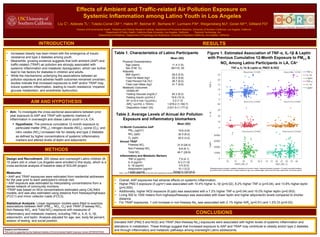
Poster_Kelly
- 1. INTRODUCTION METHODS AIM AND HYPOTHESIS Figure 1. Estimated Association of TNF-α, IL-1β & Leptin with Previous Cumulative 12-Month Exposure to PM2.5 & NO2 Among Latino Participants in LA, CAa • Increased obesity has been linked with the emergence of insulin resistance and type 2 diabetes among youth. • Meanwhile, growing evidence suggests that both ambient (AAP) and traffic-related (TRAP) air pollution are strongly associated with systemic inflammation and metabolic dysregulation, which can further lead to risk factors for diabetes in children and adults. • While the mechanisms underlying the associations between air pollution exposure and adverse health outcomes remained uncertain, studies indicate that increased exposures to AAP and/or TRAP may induce systemic inflammation, leading to insulin resistance, impaired glucose metabolism, and endothelial dysfunction. • Aim: To investigate the cross-sectional associations between prior year exposure to AAP and TRAP with systemic markers of inflammation in overweight and obese Latino youth in LA, CA. Hypothesis: The previous cumulative 12-month exposure to particulate matter (PM2.5), nitrogen dioxide (NO2), ozone (O3), and nitric oxides (NOx) increased risk for obesity and type 2 diabetes as defined by higher concentrations of systemic inflammatory markers and altered levels of leptin and adiponectin. Design and Recruitment: 200 obese and overweight Latino children (8- 15 years old) in urban Los Angeles were enrolled in this study, which is a cross-sectional analysis of baseline data of SOLAR project. Measures: • AAP and TRAP exposures were estimated from residential addresses for the year prior to each participant’s clinical visit. • AAP exposure was estimated by interpolating concentrations from a dense network of community monitors. •TRAP was based on NOx concentrations estimated using CALINE4 models, and was also estimated using distance from freeways/highways (FCC1) and minor collector roads (FCC3). Statistical Analysis: Linear regression models were fitted to examine associations between AAP (PM2.5, NO2, O3) and TRAP (Freeway NOx, Non-freeway NOx, and Total NOx) exposure with measures of inflammatory and metabolic markers, including TNF-α, IL-6, IL-1β, adiponectin, and leptin. Analysis adjusted for age, sex, body fat percent, season of testing, and social position. Table 1. Characteristics of Latino Participants RESULTS Mean (SD) Physical Characteristics Age (years) 11.4 (1.6) Sex (F/M, %) 90/110, 45 Adiposity BMI (kg/m2 ) 28.5 (5.5) Total Fat Mass (kg)a 25.2 (9.8) Total Percent Fat (%)a 38.7 (6.0) Total Lean Mass (kg)a 31.7 (9.9) Metabolic Outcomes HOMA-IRb Fasting Glucose (mg/dL)b 93.3 (6.2) Fasting Insulin (μU/mL)b 19.6 (10.3) SIb (x10-4 min-1)/µU/mL) 2.0 (1.3) AIRg b (µU/mL x 10min) 1,678.2 (1,160.7) Disposition Indexb (DI) 2,531.9 (1,177.2) Table 2. Average Levels of Annual Air Pollution Exposure and inflammatory biomarkers Table 1 and 2. Unadjusted Mean (SD) for the 200 Latino participants included in this study. N= a 205, b 195, c 143. Mean (SD) 12-Month Cumulative AAP PM2.5 (μg/m3 ) 19.8 (4.8) NO2 (ppb) 30.3 (6.2) O3 (ppb) 20.2 (3.2) Annual TRAP Freeway NOx 31.9 (29.3) Non-Freeway NOx 8.8 (6.1) Total NOx 40.7 (29.9) Inflammatory and Metabolic Markers TNF-α (pg/ml) 7.9 (4.1) IL-6 (pg/ml) 9.3 (11.9) IL-1β (pg/ml) 4.5 (5.0) Adiponectin (pg/ml)c 10.1 (3.2) Leptin (pg/ml) 25548.5 (15218.6) a Estimated percent change in metabolic indicates as a function of each 1-standard deviation increase in 12-month cumulative ambient air pollution (AAP) were observed. Analysis adjusts for age, sex, pubertal stage, total percent fat mass, seasonality, and social position. CONCLUSIONS Effects of Ambient and Traffic-related Air Pollution Exposure on Systemic Inflammation among Latino Youth in Los Angeles Liu C1 , Alderete TL1 , Toledo-Corral CM1,2 , Habre R2 , Belcher B1 , Berhane K2 , Lurmann FW4 , Weigensberg MJ5 , Goran MI3,6 , Gilliland FD2 Support and Disclaimer: This work is supported by the National Institute of Environmental Health Sciences Center (5P30ES07048). Elevated AAP (PM2.5 and NO2) and TRAP (Non-freeway Nox) exposures were associated with higher levels of systemic inflammation and alterations in metabolism. These findings suggest that increased exposure to AAP and TRAP may contribute to obesity and/or type 2 diabetes and through inflammatory and metabolic pathways among overweight Latino adolescents. 1 Division of Environmental Health, 3 Diabetes and Obesity Research Institute, Department of Preventive Medicine, University of Southern California, Los Angeles, California 2 Department of Public Health, California State University, Los Angeles, California 4 Sonoma Technology, Inc. 5 Department of Pediatrics, 6 Department of Physiology and Biophysics, University of Southern California, Los Angeles, California • Overall, AAP exposures had adverse effects on systemic inflammation. • Higher PM2.5 exposure (5 μg/m3 ) was associated with 10.4% higher IL-1β (p=0.02), 8.2% higher TNF-α (p=0.04), and 13.8% higher leptin (p=0.005). • Additionally, higher NO2 exposure (6 ppb) was associated with a 7.2% higher TNF-α (p=0.04) and 10.0% higher leptin (p=0.003). • Living 500 to 1000 meters from highways/freeways was associated with lower leptin and higher adiponectin levels compared to shorter distance. • For TRAP exposures, 1 unit increase in non-freeway Nox was associated with 2.1% higher AIRg (p=0.01) and 1.2% DI (p=0.03).